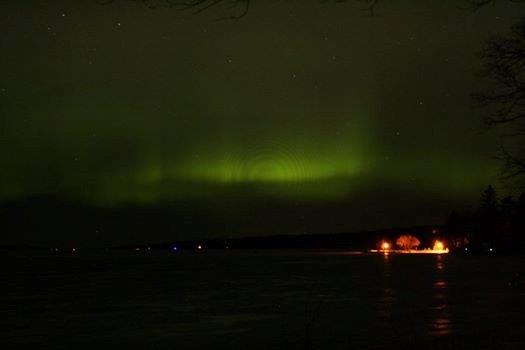Protecting the Dark Night Sky
TRADITION – Enjoying starry night skies on a quiet summer night is an important experience in the Torch Lake Watershed.
The stars, moon and planets can be awe-inspiring, romantic and fun!
Lights from our homes, driveways and walkways can disturb our view of the night sky and the views of our neighbors.
Why is the dark night sky important?
- The dark night sky gives us views into space. Without binoculars or a telescope, we can see 5,000 stars and our own galaxy, the Milky Way.
- Dark skies help us sleep better.
- Wildlife, including birds like owls, depend on darkness to hunt, conceal their location, navigate or reproduce. Many species have far more sensitive vision than humans. Light pollution disrupts their behavior, habitat and migration.
- Plants need the natural rhythms of light and dark, too.

Photo: Brad McArtor
How can you make a difference?
You can help restore the dark night sky. It is simple to do . . .
Enjoy the dark night sky.
Take the time to experience the dark night sky with your family and friends. Learn to identify the constellations, important stars and planets. Watch a meteor shower. Find the best sky watching dates here.
Use light only when you need it.
Install motion sensors and timers to insure lights are on only when needed. This costs less money, improves security and reduces light pollution.
Shield your lights.
Direct light where it’s needed rather than scattering it in all directions. Shielding lights downward reduces glare and light pollution. Many local zoning ordinances require lights have shields so they shine down rather than out and up.
Use less light.
Turn off lights at night. Artificial light blocks starlight.
Electric lighting began with incandescent light bulbs. Now we have compact fluorescent lamps (CFL) and light emitting diodes (LED).
Newer, second generation LED lights are now both energy- and cost-efficient. Switch to LED lighting.
Comparison energy efficiency of light bulbs.
Brightness is measured in lumens while wattage is the amount of energy needed to produce that level
of brightness.
LED bulbs require less wattage than CFL or incandescent light bulbs. Lower wattage to produce the
same brightness is the better choice.
| Lumens (Brightness) | Incandescent Watts | CFL Watts | LED Watts |
|---|---|---|---|
| 400-500 | 40W | 8-12W | 6-7W |
| 650-850 | 60W | 13-18-W | 7-10W |
| 1000-1400 | 75W | 18-22 W 1 | 2-13W |
| 1450-1700+ | 100W | 23-30W | 14-20W |
| 2700+ | 150W | 30-55W | 25-28W |
Use Less Energy & Save Money
Comparison cost-efficiency of light bulbs.
LED bulbs are cheaper when comparing the price over time with energy consumption.
LED bulbs use less electricity, so they contribute less to global warming.
| Incandescent | CFL | LED | |
|---|---|---|---|
| Watts used | 60 W | 14 W | 7 W |
| Average Cost per Bulb | $1 | $2 | $4 |
| Average Lifespan | 1,200 hours | 8,000 hours | 25,000 hours |
| Bulbs needed for 25,000 hours | 21 | 3 | 1 |
| Total purchase price of bulbs over 20 years | $21 | $6 | $4 |
| Cost of Electricity 25,000 hours at $0.15 per kilowatt-hours | $169 | $52 | $30 |
| Total estimated cost over 20 years | $211 | $54 | $34 |
Talk to your neighbors.
Have a neighborhood Telescope party, Star party or Meteor Shower party. Invite an amateur astronomer as a VIP to learn more about the dark night sky. Check out the cell phone app: Star Walk to find out what’s happening each night.
Reduce use of aerosol cans.
Aerosols in the atmosphere scatter light: some returns to Earth as light pollution (sky glow), some is redirected, and some is re-reflected.
What can you see in the dark night sky?
- Moonlight – Phases of the moon
- Starlight – Constellations
- Galactic light – Milky Way
- Zodiacal light – Dawn & dusk
- Shooting starlight – Meteor showers and comets
- Northern lights – Aurora borealis (solar storms entering Earth’s atmosphere)
Click here for this year’s dark sky events.
Talk to your neighbors.
Have a neighborhood Telescope party, Star party or Meteor Shower party. Invite an amateur astronomer as a VIP to learn more about the dark night sky. Check out the cell phone app: Star Walk to find out what’s happening each night.
Reduce use of aerosol cans.
Aerosols in the atmosphere scatter light: some returns to Earth as light pollution (sky glow), some is redirected, and some is re-reflected.
What can you see in the dark night sky?
- Moonlight – Phases of the moon
- Starlight – Constellations
- Galactic light – Milky Way
- Zodiacal light – Dawn & dusk
- Shooting starlight – Meteor showers and comets
- Northern lights – Aurora borealis (solar storms entering Earth’s atmosphere)
Click here for this year’s dark sky events.
Don't just wish that Torch Lake will stay blue.
Choose a water-friendly lifestyle - make a difference!
